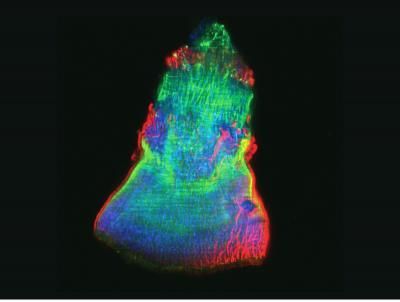Umbilical cord could be new source of plentiful stem cells, say Pitt researchers
Banking cords, as well as cord blood, may be invaluable
Advertisement
stem cells that could one day provide therapeutic options for muscle and bone disorders can be easily harvested from the tissue of the umbilical cord, just as the blood that goes through it provides precursor cells to treat some blood disorders, said University of Pittsburgh School of Medicine researchers in the Journal of Biomedicine and biotechnology .
Umbilical cord tissue cells can be expanded to greater number, are remarkably stable and might not trigger strong immune responses, said senior investigator Bridget M. Deasy, Ph.D., assistant professor in the Department of Orthopaedic Surgery, Pitt School of Medicine. The cells are obtained from the gelatinous material in the cord known as Wharton's jelly and from blood vessel walls.
"Our experiments indicate also that at least 21 million stem cells, and possibly as many as 500 million, could be banked from a single umbilical cord after the birth of a baby," she noted. "So, the cord could become an accessible source of a multitude of stem cells that overcomes many of the restrictions, such as limited quantity as well as donor age and donor sex issues, that come with other adult stem cell populations."
Dr. Deasy and her team analyzed sections of two-foot-long human umbilical cords that were donated for research, looking for cells in Wharton's jelly and blood vessel walls that displayed the characteristic protein markers found in stem cells derived from other sources. The researchers then sought to find the best way to isolate the stem cells from the cords, and tested them in the lab to confirm their ability to produce specialized cells, such as bone and cartilage, while retaining their invaluable ability to renew themselves.
To build on these findings, the team will test the umbilical cord stem cells in animal models of cartilage and bone repair, as well as muscle regeneration.
Topics
Organizations
Other news from the department science

Get the life science industry in your inbox
By submitting this form you agree that LUMITOS AG will send you the newsletter(s) selected above by email. Your data will not be passed on to third parties. Your data will be stored and processed in accordance with our data protection regulations. LUMITOS may contact you by email for the purpose of advertising or market and opinion surveys. You can revoke your consent at any time without giving reasons to LUMITOS AG, Ernst-Augustin-Str. 2, 12489 Berlin, Germany or by e-mail at revoke@lumitos.com with effect for the future. In addition, each email contains a link to unsubscribe from the corresponding newsletter.

























































